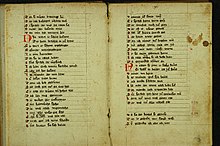Plot
Gregorius' parents are aged approximately 11 when he is born and are the orphaned children of a wealthy duke, and his father dies after being sent on a pilgrimage from Europe to Jerusalem to repent of their sins by a wise old man. The same wise old man tells Gregorius' mother to place the child in a box on a small boat and to push the boat out onto the ocean, where God will take care of the child. She dutifully does this, placing 20 pieces of gold in with him, alongside a tablet upon which the details of his sinful birth are recorded. The boat is discovered by two fishermen sent by an abbot to fish on the sea, and upon opening the box when they arrive back on shore, the abbot orders one of the fisherman to raise the child as his son. Aged six, Gregorius begins his education under the abbot's guidance, and as he grows, quickly becomes very clever, strong, and handsome, revealing to all that he cannot merely be the son of a poor fisherman.
In late adolescence he discovers his adoptive family are not his own, and after much debate with the abbot leaves the monastery to pursue a life of chivalric duty as a knight in order to repent of his parents' sin which he discovers when the abbot reveals a tablet to him which relates the story of his birth. Through his knightly prowess wins the hand of the mistress of a besieged city. They marry, and one day as he is out hunting, a maid shows his wife to the room where he has kept the tablet, and from which he always emerges terribly sadly with eyes red from crying. With horror, his wife recognizes the tablet and discovers she is not only his wife, but also his mother and his aunt. Upon hearing of this, Gregorius exiles himself to go and live a humble life in poverty repenting for his sin. He tells his mother to distribute her wealth to the poor and to live a life of poverty as penance for her sins too.
Gregorius asks to be put on a rock in the middle of a lake by a fisherman, who tosses the key to Gregorius' chains (which bind him to the rock) into the lake and tells Gregorius that, should the key ever be rediscovered, he will know that Gregorius is indeed a holy man and has been forgiven by God. Seventeen years later, God tells two elderly clergymen in Rome that the next pope is to be found repenting a grave sin upon a rock in Aquitania. They ride off to find him, and find the lake and the fisherman, who greedily sells them a meal instead of offering them a gift of sustenance. Upon gutting the fish however, he discovers the key to Gregorius' chains and is horrified to have chained a holy man to a rock, even more so because he presumes that after seventeen years, the man must surely be dead. He takes the two men to the rock, where they discover the emaciated Gregorius, who has survived thanks to the Holy Spirit and a trickle of water emerging from the rock. The fisherman throws himself to his knees and laments of his sin, terrified that he is now too old to still have time to properly repent. However, the narration tells us that his grief is so sincere that his soul is saved. He unlocks Gregorius, who goes off with the two men to become pope.
Once in office, he meets his mother, who has done exactly what she was bidden to do by him and led a life of extreme poverty. She does not recognize him, but he tells her who he is, and that they have been forgiven by God, in accordance with the proper repentance they have fulfilled.

The Jesus Prayer, also known as The Prayer, is a short formulaic prayer, esteemed and advocated especially in Eastern Christianity and Catholicism:
Lord Jesus Christ, Son of God, have mercy on me, a sinner.

The Tower of Siloam was a structure which fell upon 18 people, killing them. Siloam is a neighborhood south of Jerusalem's Old City. In the Gospel of Luke, Jesus refers to the tower's collapse and the death of the 18 in a discourse on the need for individual repentance for sin. The incident is mentioned only once in the New Testament, in Luke 13:4, as part of a section with examples inviting repentance contained in verses 13:1–5.
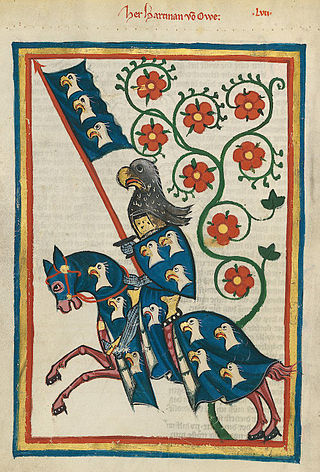
Hartmann von Aue, also known as Hartmann von Ouwe, was a German knight and poet. With his works including Erec, Iwein, Gregorius, and Der arme Heinrich, he introduced the Arthurian romance into German literature and, with Wolfram von Eschenbach and Gottfried von Strassburg, was one of the three great epic poets of Middle High German literature.

The Parable of the Prodigal Son is one of the parables of Jesus in the Bible, appearing in Luke 15:11–32. In Luke 15, Jesus is said to tell this story, along with those of a man with 100 sheep and a woman with ten coins, to a group of Pharisees and religious leaders who kept on criticizing him for welcoming and eating with marginalized Jews including tax collectors and other sinners.

Repentance is one element of atoning for sin in Judaism. Judaism recognizes that everybody sins on occasion, but that people can stop or minimize those occasions in the future by repenting for past transgressions. Thus, the primary purpose of repentance in Judaism is ethical self-transformation.

Alice Auma was an Acholi spirit-medium who, as the head of the Holy Spirit Movement (HSM), led a millennial rebellion against the Ugandan government forces of President Yoweri Museveni from August 1986 until November 1987. The primary spirit she purportedly channelled was that of a dead army officer called "Lakwena", meaning messenger, which the Acholi believe to be a manifestation of the Christian Holy Spirit. The combined persona of Alice Auma channelling the spirit Lakwena is often referred to as "Alice Lakwena". Auma's HSM was ultimately defeated in November 1987 by Ugandan forces led by Yoweri Museveni.
In Christian hamartiology, eternal sin, the unforgivable sin, unpardonable sin, or ultimate sin is the sin which will not be forgiven by God. One eternal or unforgivable sin, also known as the sin unto death, is specified in several passages of the Synoptic Gospels, including Mark 3:28–29, Matthew 12:31–32, and Luke 12:10, as well as other New Testament passages including Hebrews 6:4–6, Hebrews 10:26–31, and 1 John 5:16.
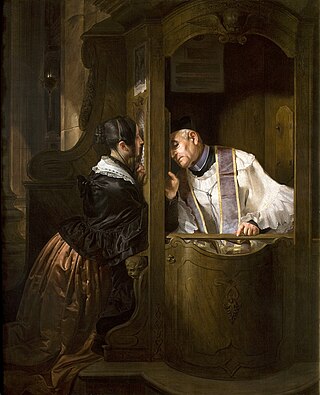
Absolution is a theological term for the forgiveness imparted by ordained Christian priests and experienced by Christian penitents. It is a universal feature of the historic churches of Christendom, although the theology and the practice of absolution vary between Christian denominations.
Tawba is the Islamic concept of repenting to God due to performing any sins and misdeeds. It is a direct matter between a person and God, so there is no intercession. There is no original sin in Islam. It is the act of leaving what God has prohibited and returning to what he has commanded. The word denotes the act of being repentant for one's misdeeds, atoning for those misdeeds, and having a strong determination to forsake those misdeeds. If someone sins against another person, restitution is required.
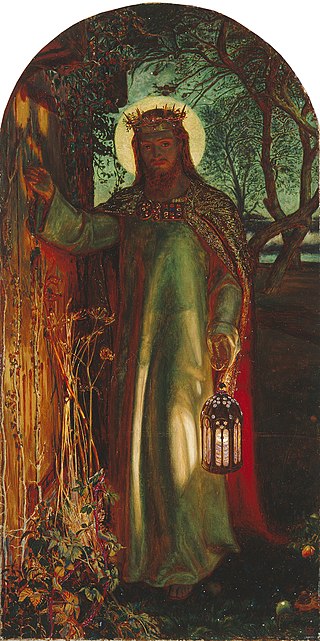
The Sinner's prayer is an evangelical Baptist term referring to any prayer of repentance, prayed by individuals who feel sin in their lives and have the desire to form or renew a personal relationship. This prayer is not mandatory but, for some, functions as a way to communicate with and understand their relationship with God through Jesus Christ. It is a popular prayer in evangelical circles. It is not intended as liturgical like a creed or a confiteor said or chanted within the Catholic Mass, but rather, is intended to be an act of initial conversion to Christianity. It is roughly analogous to the Catholic Act of Contrition, though the theology behind each is markedly different, due to the intrinsically different views of salvation between Catholicism and Protestantism. While some Christians see reciting the Sinner's prayer as the moment defining one's salvation, others see it as a beginning step of one's lifelong faith journey.

Elisabeth of Schönau was a German Benedictine visionary. She was an abbess at the Schönau Abbey in the Duchy of Nassau, and reportedly experienced numerous religious visions, for which she became widely sought after by many powerful men as far away as France and England.
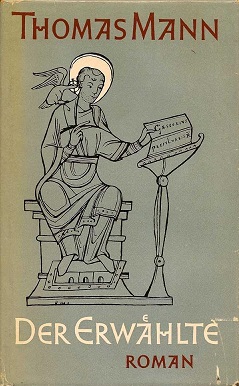
The Holy Sinner is a German novel written by Thomas Mann. Published in 1951, it is based on the medieval verse epic Gregorius written by the German Minnesinger Hartmann von Aue. The book explores a subject that fascinated Thomas Mann to the end of his life – the origins of evil and evil's connection with magic. Here Mann uses a medieval legend about "the exceeding mercy of God and the birth of the blessed Pope Gregory" as he used the biblical account of Joseph as the basis for Joseph and His Brothers, illuminating with his ironic sensibility the notion of original sin and transcendence of evil.
Der Pleier is the pen name of a 13th-century German poet whose real name is unknown. Three of his works survive, all Middle High German romances on Arthurian subjects: Garel, Tandareis und Flordibel, and Meleranz. Little else is known of him, but he was an important figure in the revival of Arthurian literature in Germany in the mid-13th century, after decades of declining interest in the subject.

New England theology designates a school of theology which grew up among the Congregationalists of New England, originating in the year 1732, when Jonathan Edwards began his constructive theological work, culminating a little before the American Civil War, declining afterwards, and rapidly disappearing after the year 1880.

Inferno is the first part of Italian writer Dante Alighieri's 14th-century narrative poem The Divine Comedy. It is followed by Purgatorio and Paradiso. The Inferno describes the journey of a fictionalised version of Dante himself through Hell, guided by the ancient Roman poet Virgil. In the poem, Hell is depicted as nine concentric circles of torment located within the Earth; it is the "realm [...] of those who have rejected spiritual values by yielding to bestial appetites or violence, or by perverting their human intellect to fraud or malice against their fellowmen". As an allegory, the Divine Comedy represents the journey of the soul toward God, with the Inferno describing the recognition and rejection of sin.
Der arme Heinrich is a Middle High German narrative poem by Hartmann von Aue. It was probably written in the 1190s and was the second to last of Hartmann's four epic works. Combining courtly and religious narrative patterns, it tells the story of a noble knight who has been stricken by God with leprosy and can be cured only by the heart's blood of a virgin who willingly sacrifices herself for his salvation.

Iwein is a Middle High German verse romance by the poet Hartmann von Aue, written around 1200. An Arthurian tale freely adapted from Chrétien de Troyes' Old French Yvain, the Knight of the Lion, it tells the story of Iwein (Yvain), a knight of King Arthur's Round Table. It was written after Hartmann's Erec, and is generally taken to be his last work.
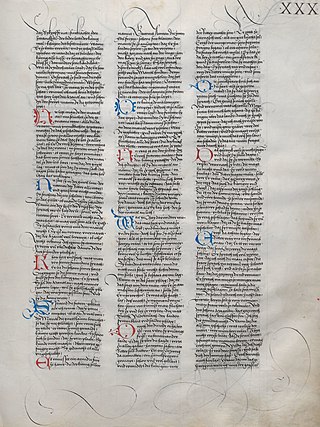
Erec is a Middle High German poem written in rhyming couplets by Hartmann von Aue. It is thought to be the earliest of Hartmann's narrative works and dates from around 1185. An adaptation of Chrétien de Troyes' Erec et Enide, it is the first Arthurian Romance in German.
Guiomar is the best known name of a character appearing in many medieval texts relating to the Arthurian legend, often in relationship with Morgan le Fay or a similar fairy queen type character.
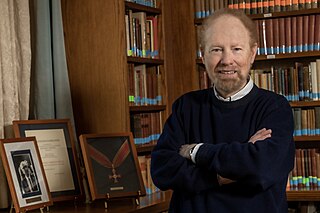
Michael Resler is a philologist, academic, and author, specializing in the late-12th- and early-13th-century German Arthurian romance. He is a professor of German Studies at Boston College.
